Psst! The stock market is up, retail sales are up, consumer confidence is on the rebound...time to splash new sponsorship decals on these race cars
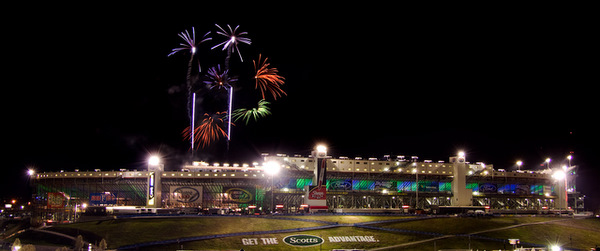
And the Sprint Cup tour's next stop is -- Bristol! (Photo: Bristol Motor Speedway)
By Mike Mulhern
mikemulhern.net
LAS VEGAS
Hey, go out and buy something, anything.
That's been the message…and this week there's more good news on the U.S. economic front, where American retailers are reporting a surge in business.
Now out here on the frontlines of NASCAR's Wild, Wild West, well, if you don't already have tickets to Bristol and Martinsville, the next two tour stops, you'd better get 'em quick: http://bit.ly/kuGqP and http://bit.ly/2eciKW .
At least that's what promoters Jeff Byrd and Clay Campbell are pushing.
Buying? The other side of that equation, naturally, is selling…..
So, 'Hey, you over in the corner cubicle:'
"If you're in marketing, and your boss is whipping you because sales revenues have gone down, and he wants to know what you're doing differently to help the company get back to where it was….you people need to be looking at NASCAR…with fresh eyes…or for the first time," Geoff Smith says.
Smith runs the business side of Jack Roush's racing operations, and he senses the moment is here, finally, for this sport to launch a sponsorship charge: "So it's important for us not to get bogged down in the wrong debate, and rather to marshal our assets, so the group as a whole can make more persuasive arguments" to potential sponsors.
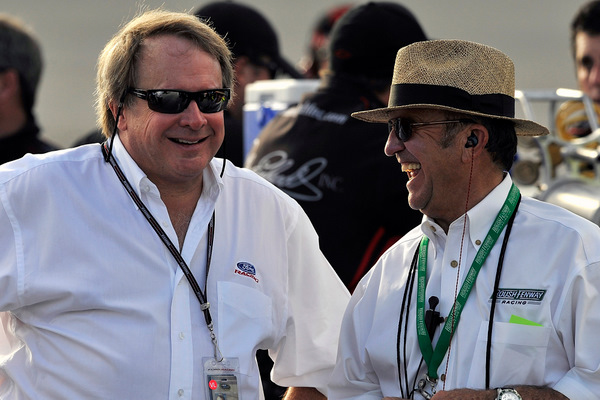
So look at the standings -- Jack Roush (R, with Edsel Ford) has two of the top three right now. Maybe this is shaping up as a Roush-versus-Richard Childress season....and Roush still hasn't forgotten 1990.... (Photo: Autostock)
Okay, let's look at the production side here. While it's a Michael Schumacher weekend over in F1 Bahrain, and the stock car world awaits next week's Bristol, Tenn., face-to-face milk-and-cookies in the NASCAR trailer between Brad Keselowski and Carl Edwards over their Atlanta run-ins, let's consider what we've learned in the first 38 days of the U.S. racing season, since that Media Frenzy Day at Daytona.
Yes, this is a performance business, stock car racing….and the American economy.
And while we're still waiting to see the results of the runs with that new 'old' flat-blade spoiler at Phoenix and Texas in the coming week (Talladega's testing is March 16th, Charlotte the 23rd, and the March 28th stop at Martinsville the first test, albeit more for the inspection procedures than the racing), we can perhaps see some general trends by looking at the Sprint Cup standings after Daytona, California, Las Vegas and Atlanta:
Richard Childress' Kevin Harvick, though winless, is atop the standings.
Roush's Matt Kenseth, though winless too, is second, just 26 points down. And teammate Greg Biffle, also winless, is third.
Double-winner Jimmie Johnson is fourth.
Childress' Clint Bowyer and Jeff Burton are fifth and sixth.
Hmmmm. that's all three Childress Chevy teams and two Roush Ford teams in the top-six.
Change?
Maybe this is the season of change.
In fact Ford's Paul Menard, perhaps underrated these past few years and only now showing his potential under new crew chief Slugger Labbe, is ninth in the standings.
And Scott Speed is 12th?
Hmmm.
If the chase began this week, Dale Earnhardt Jr. and Kyle Busch wouldn't make the cut.
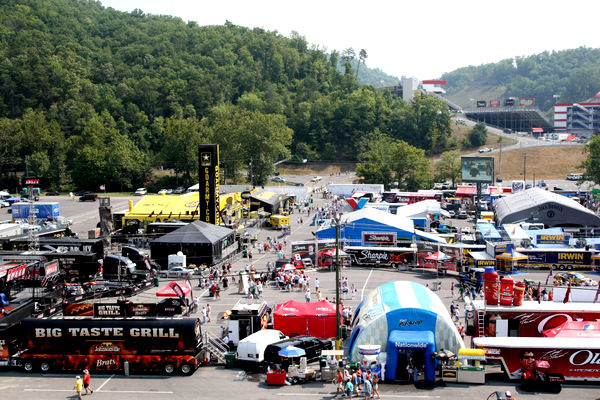
NASCAR retailers out on Souvenir Row would like a piece of the new action too (Photo: Getty Images for NASCAR)
But the real hard news this week – well, aside from the Edwards-Keselowski-NASCAR debate -- looks like it's out in the economy.
American consumers, after being hunkered down for so long, are starting to flood back out into the shopping mall, and not just Pollyannas, which has to be good news for stock car team owners, who are always working the marketplace for sponsorship.
Retails sales are up, and the key industry areas are electronics, building materials, garden supplies (despite the snowstorms), books, music, sporting goods, and restaurants, all sorts of stuff that people have to actually go out and buy in person. And this is the fourth month of such gains over the past five months, showing some momentum.
Owners are certainly being creative: Biffle carrying sponsorship from the U.S. government's Census push ("Send in those census forms, or I'll be knocking on your door"); rookie Kevin Conway carrying sponsorship from ExtenZe.
Ford's Smith says the game is afoot and there's not time to be wasted, that NASCAR team owners need "to marshal" all their marketing resources.
TV? TV ratings?
Smith says that's a false marketing god.
Chevrolet's Brent Dewar agrees: "Gross ratings points aren't important."
And Ford's own top marketing men will be at Bristol to add to the marketing debate.
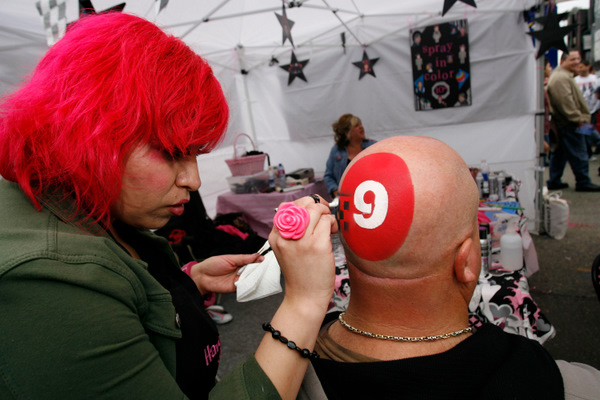
Yes, stock car racing fans come in all shapes and sizes....and just which demographic profile does this dude fit into? (Photo: Getty Images for NASCAR)
But how to make the pitch? How to make impact at point of purchase? How to sell a deal….to the potential sponsor as well as the hoped-for consumer?
GM's Brent Dewar, the Chevy boss who is leaving in a few weeks, concedes U.S. media today "is unstructured," which makes for a big challenge for anyone – from Ford Motor Company to mikemulhern.net – to get its message out to the masses.
So Dewar points to 'vertical' marketing, because, he points out, "the message is there," it's just a matter of finding it amid all the clutter.
It's something like having two or three dozen Sunday New York Times dumped on your front porch every morning and having to sift through them all.
Little wonder that the new buzz phrase in media consumption by the typical American is 'grazing.'
Americans 'graze' through the news…like eating at some giant media buffet.
That is good in a sense, because Dewar says it's easier now to target a specific audience, though he says it is more work, though the rewards are more, because the messaging is more targeted.
But how to measure all that impact isn't easy. And Smith says it's time for NASCAR's team owners to rally together, to share economic information on how this sport works for sponsors and could work for potential new sponsors.
Geoff Smith, head of Jack Roush's racing operations, says TV ratings may be superfluous, distracting from the demographic heart of the sport (Photo: Getty Images for NASCAR)
TV ratings? Smith curtly dismisses that weekly debate:
"I've been to seminars where other major league sports are represented, and that (TV and TV ratings) is the only thing – the only thing – they care about," Smith says. "I mean the only thing…because it's the biggest source of revenue for them, for the players and the organizations.
"So naturally every time a TV executive opens his mouth, it's about how much less he wants to pay (for sports rights) the next time…while the owners want to talk about how much more they're going to get next time…and the players want to talk about how much bigger a share of the pie they're going to get.
"And that takes you right into the issue 'Well, if there aren't any more 18-to-34-year-old men (watching), then we're not going to pay any more money.'
"That issue gets so loud and such play that eventually people think the success or failure of the sport is based on how large the 18-to-34-year-old male audience is….and that is not a demographic that most sponsors in this garage are terribly worried about."
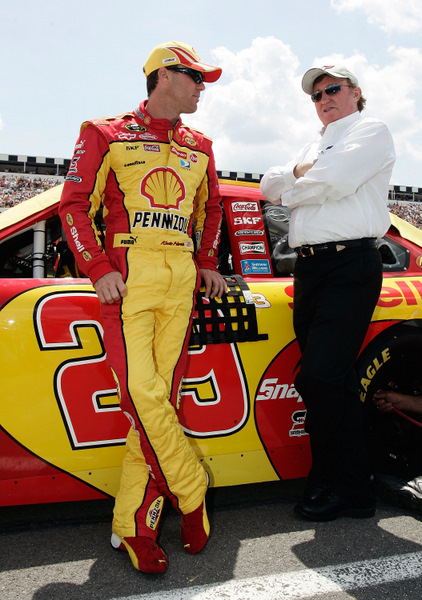
Top wrangler on the NASCAR tour.....wrangler, wrangler....Wrangler? (Photo: Getty Images for NASCAR)
Analyzing demographics may be as much an art form as a science of course. And just getting the numbers themselves isn't easy.
Well, for starters, let's try here (figures from 2005-2007):
1. Of all NASCAR fans, 30 percent were 18-to-34-year-olds, 41 percent were 35-to-54-year-olds, and 28 percent were 55-plus. That obviously means that some 70 percent of NASCAR fans were not 18-34.
2. About 62 percent of NASCAR fans were men, 38 percent women.
3. About 35 percent of NASCAR fans earned $40,000 a year or less, about 32 percent earned $75,000 or more.
4. About 30 percent of NASCAR fans owned either Pontiacs or Chevrolets, about 30 percent owned Fords, about 13 percent owned Dodges, about 14 percent owned Toyotas.
Some other interesting figures to consideration, the NASCAR hotbeds around the country:
-- Charlotte, Winston-Salem/Greensboro/High Point, Indianapolis, Roanoke, and Toledo are the hottest, with at least half the people surveyed expressing interest in NASCAR.
-- The weakest areas for NASCAR fans – New York City, Miami, Los Angeles/San Diego, Boston, Seattle, San Francisco, Chicago, Philadelphia, Houston, Phoenix, Detroit, Denver, Washington/Baltimore, and Dallas/Fort Worth, with less than 30 percent expressing interest in NASCAR.
(Numbers are from Scarborough Research, in partnership with Nielson and Arbitron. These figures were compiled during the 2005 to 2007 period, NASCAR's clear peak period lately, and the numbers appear consistent from season to season.)
But then just how relevant are even those numbers, when it comes to marketing through NASCAR? Is all that just the low-hanging fruit?
Does someone even have to be a NASCAR 'fan,' whatever that really is, to be impacted by sports marketers?
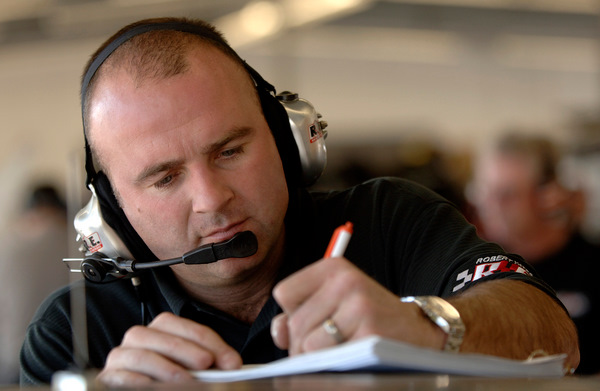
Crew chief Slugger Labbe, has Paul Menard looking hot (Photo: Autostock)
And television, Smith says, is only part of the big picture: "While TV is important -- it means money for all of us (team owners share 25 percent of the TV money; 10 percent goes to NASCAR itself; the rest goes to the various track owners, principally Bruton Smith's Speedway Motorsports and the France family's International Speedway Corp.), and it means exposure for the sport – but whether TV floats up or down, it's only one component.
"You have to understand all the other components – which NBC (in its Olympics analysis) is calling the 'total audience index.'"
That 'total audience index' for NASCAR racing is apparently not available…yet.
"We need to gather up that data," Smith says of this sport and its teams. "We've got digital communications in the millions of impressions and exposures, MRN and PRN radio, we've got the shoulder (TV) programming, and all these things.
"And we also have like 600 corporate sponsors, making investments over and above what you see on the track. And those investments place our sport into everyday life in the communities everywhere in the country."
Indeed that is one major reason why California's Auto Club Speedway, in eastern Los Angeles, is so important to this sport, regardless of the grandstands or TV ratings for those two Cup weekends – LA is a critical market for every company selling in the U.S. And NASCAR needs a strong presence there.
Smith agrees: "NASCAR is a 365-day sport, and it's in every market in America. You can't go into a grocery store or watch a television show without seeing signs of the sport.
"Sponsors all want return-on-invest justification models. And one of those asks 'How many people in how many stores see it? And what advertising goes around it?'
"Take a grocery store for example. Kellogg's is on Carl Edwards' car, and Kellogg's will do millions of weekly coupons with promotions…and then the product is in the store too. And sometimes that's supported by TV advertising on top of it.
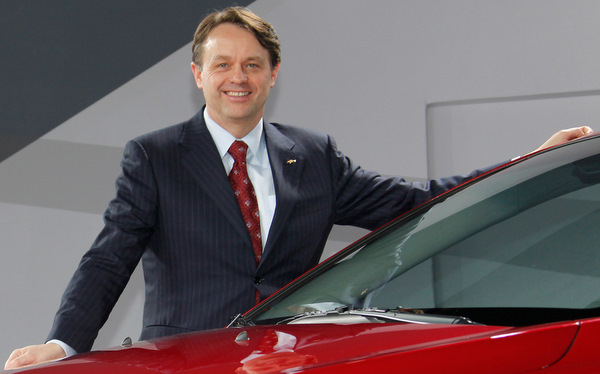
GM's Brent Dewar (here) says TV eyeballs are just a small part of the marketing equation, and Ford's Geoff Smith agrees (Photo: GM)
"We did a study when we had Citgo as a sponsor – they had the TV measurement, which had fallen off some, mainly because our performance had fallen off some on that program." Smith went on.
"But when we went in and got all the exposures – from the associate sponsors, and the advertising and promotions they did – there were I think something like 30 million packages of Kraft's Velveeta cheese with Jeff Burton's picture on them.
"This is one reason why when you go around to sponsors, they very rarely list TV exposure as the single most important return they need.
"They want to connect with the overall demographic of the people who will make purchase decisions…and they want to be in their community…they want to be with them every day, in some way…
"They want exposure on TV and in the media in general. But they want to build equity with the consumer, that says 'Here, I have a team I am sharing with you. You share with me, and I'll share with you.'
"I am absolutely convinced we have an incredible story when we marshal our resources, and we can tell that story with empirical evidence.
"So this is an example of the information that we and our sponsors are not giving to the potential sponsors of this sport.
"If you were to go through the demographics that are needed to make this sport successful, you would find that the demographics of our sport actually reach a broad range of America, a very broad range. The demographics of this sport are reflected in the communities we go to."
Should NASCAR itself be providing more marketing support for the teams?
"There have been people who have tried to push that burden on to NASCAR – 'Do more for me,' " Smith says.
"But they are not the experts, like we are, on what makes team sponsorships the most valuable.
"They do have assistance they provide, and we can all access a lot of their intellectual resources, though it hasn't been done in a very coordinated way…which we are working on improving.
"But we can't wait.
"We've got this down economy, and this is a time when marketing dollars have been withheld from the marketplace in general…and they've got to be re-released."
[Note: You can use Twitter as an easy headline service for mikemulhern.net stories, with our instant Tweets to your mobile as soon as our newest NASCAR story is filed. And mikemulhern.net is mobile-friendly for viewing. You can also use the orange RSS feed button as a quickie headline service on your laptop or home computer for mikemulhern.net stories, by creating a Live Bookmark RSS feed on your web browser's toolbar. Or you can create a Google Alert for mikemulhernnet.]
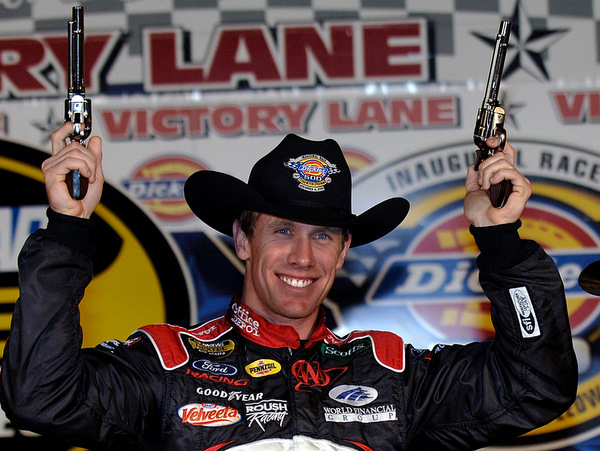
If NASCAR wants the Sprint Cup tour to be a Wild, Wild West show, as it begins the march toward Phoenix (April 10) and Fort Worth (April 18), well, this guy looks quite willing to oblige (Photo: Autostock).
© 2010-2011 www.mikemulhern.net All rights reserved.
Web site by www.webdesigncarolinas.com







Interesting article. I have
Interesting article. I have always thought that Geoff Smith is one of the smartest people in racing, although--I don't know this to be true--I have long suspected that he is partly responsible for the rampant escalation of sponsorship cost. That may or may not be true. And I bet he has used that "18-34 year old" argument to his benefit in the past. But being 54 myslef and having a high-earning power and a college degree I have always resented the demographics that TV puts us in. So, what the over 50 crowd doesn't watch TV? Doesn't watch as much as 18-34 year olds? Don't have better buying power as a general rule than 18-34s? Hell when I was 18-34 I rarely watched TV, was at bars, out to eat, frolickin, at receptions, etc. Watched TV the least of my whole life and cared about it less. Now I am an old fart watchin TV more and the decision makers care about me less? Somethins amiss in the data points I would suggest. But Smith has great points...And this America she is a changin, changin more rapidly in the past 10 years than I have seen perviously in 30 years. Print news, who wudda thunk that would fall as fast as it did? Lehman, AIG, GM, add revenue, housing, banking (BofA not chargin debit overdraft fees! What is the world comin too?), and on and on. So NASCAR/ISC/team owners and promoters better put their thinking caps on and prepare for the long haul. And by the way, I thnk JImmie Johnson is correct the way some of these tracks market tickets and their foolish events shows they haven't a clue how to sell a ticket or what's important to fans' wallets. Shame on them. They haven't had to do any thinking up until now.
what, you dont think
what, you dont think paintball fights sell tickets (LOL)?
Interesting comments about
Interesting comments about Southern California. The LA/San Diego market ranks near the bottom in terms of interest in NASCAR. However, it's important for NASCAR to keep a "strong presence" there because so much commerce takes place there. Now I understand why NASCAR is trying so hard to make it work there.
I wonder what "strong presence" means? Does having two half-empty races a year mean NASCAR has a strong presence? The better question is: what does NASCAR do to increase there presence? Would a single race create enough demand for tickets to create a "buzz" in the market and increase NASCAR's presence? Or, does NASCAR need to go twice a year to remind people of their strong presence? (Apparently, NASCAR and Gillian Zucker agree with the latter.)
This is all too much for my little brain to think about. I'd rather just watch the races and talk about the cars, drivers and competition. Part of me wished the sponsors would stay away, so we could get back to grass-roots racing. But, I suppose that's what the local short tracks are for. Good thing Spring is almost here.
Ah, springtime.....hope it
Ah, springtime.....hope it doesn't blizzard in bristol (remember a few years ago the whiteout?)....and i can head over to jerry long's garden shop -- remember him, the rjr executive who did more to make nascar what it is today than anyone can remember. jerry long belongs in the nascar hall of fame for sure....
LA/San Diego, i agree, is too much for me to really digest. wonder what the nfl would do there if it still had an LA franchise....and why did that bunch leave town anyway? i cant remember....
I can't say I remember Mr.
I can't say I remember Mr. Long. I'm either not as old or not as smart as I think I am.
I don't remember why the Rams left LA. The Raiders left because they couldn't get a good stadium deal - which is also why they left Oakland. Some people think Al Davis just uses LA to get a good stadium deal out of Oakland.
LA still doesn't have an NFL-class stadium. Last I heard, "they" were trying to build one in Industry, CA, but the people who live in the bedroom communities around Industry were blocking it.
There's lots of rumors as to who might move to the stadium once it's built, but I don't know what the schedule is.
The Rams left LA because they
The Rams left LA because they had no audience there. The Raiders left ostensibly over a stadium deal but in reality left because there was no audience for them in LA, either - they still drew from Oakland.
Supposedly the new stadium for LA is being built. The rumors are that the Jacksonville Jaguars were asked to move there in 2011, but that makes no sense between being an AFC South team and also with Orlando picking up some of their home games.
The reality is LA is not a great market; it has a lot of bettors but not a committed audience for sports beyond the Lakers and maybe the Dodgers. NASCAR and Indycars fizzled out with Ontario Motor Speedway and then Riverside, and they've never responded well to Fontana. The NFL was there for over 30 years and ultimately fizzled out.
Post new comment